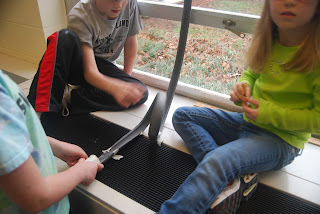- Making waves with strings and ropes
- Making waves with a slinky
- Making nodes and anti nodes with a slinky on a string
- Earthquake impacts and characteristics
Before starting, I had to get a couple of slinkies and build some devices for the stations. I found the slinkies at Toys R Us. They had the metal versions and the plastic one. I bought several of the large metal versions and one plastic slinky. The plastic ones are not really good for demonstrating wave propagation, so make sure you get the big metal ones. I will explain why I bought the large plastic slinky later in the description of the earthquake station.
In the first station that I listed above, we used different types of string a rope and let the students generate waves. I used light weight string, elastic string, and a light weight rope. The elastic string was able to generate the waves with the most nodes. If you look carefully at the photo below, you can see the rope in the middle with some waves. This was a popular station and one that I have seen in books and one the internet. This experiment I looked at the book Making Waves by Bernie Zubrowski. What we found is that it is very hard to make waves with a student at each end moving the string. It works better if one person holds the string or rope steady and then the other makes the waves. The idea was to try and make one wave, then two, then three, and then to make as many as you could. The idea was for each student to try and make waves with each material so that they could find out which material allowed them to make the most waves.
Another station that was popular was the slinky station where we had the students make a P or pressure wave with the slinky. You have one student at each end of the slinky, and have them back up so they have the slinky stretched out quite a bit. Then as you can see below with the student on the right. Have them cup their hands, then strike their hand with the other hand to create the pressure wave. When I did the demonstration for all of the students before we started, the kids all oohed and ahhhed. I was surprised that they would be so excited seeing the wave in the slinky, but I have to admit, it is pretty cool! I also had them produce S or shear waves on the floor. If you have them make S waves with the slinky in the air it often gets out of hand and results in very tangled slinkies. You can see a great visual graph of P and S waves at the Purdue University site.
One internet source which is a great help in finding fun hands-on activities is the Exploratorium Snack page. The activity I used was "Slinky in Hand". I set up a slinky on a fishing line that was tied between two chairs. With the slinky you can do some interesting things with compression waves. I used a 10 pound line, although the instructions said use a 20 pound line. I think a good thick line is indeed needed. The first class broke the fishing line in the first few minutes. I then tied a thin cotton string to the chairs and used that. However, the monofilament line is better because it has a lot less friction than the string. From the series of photos below, you can see how the students can make pressure waves with the slinky by either moving their hands toward each other in a clapping motion, or moving them together in sync. However, we found that moving together in sync is pretty hard, and if you get two people who work well together, they can act as if they are sawing a tree and get multiple wave forms that way.
For a couple of the experiments showing the earthquakes, you need to attach the slinky's to a small block of wood. That setup is described on a website about Earth Science at Purdue University. If you look at the Seismic Waves writeup, you can see how to build a couple of the devices that I used. I show a photo below of drilling a hole into a block of wood. I then used screws and washers to secure the last slinky link to the block of wood, and then built a little house per directions on the website.
This is a photo of the final device in action. A student is generating a wave and shaking the building and you can see how it is leaning to the left as a result of the "earthquake".
In this earthquake station I also had the metal and plastic slinky's taped together to show how the waves propagate differently through different types of material just as a earthquake would propagate through different types of rock. This device works quite well. It also works well to have the kids put it on the floor and generate S or shear waves and see how the propagate differently in the metal vs. the plastic. This was a popular station.
Overall, I think this set of experiments worked well. I think I would do a little tweaking. I think I would use a set of whacking balls. You can use marbles and string, but buying a set of these balls, called Newton's cradle, would be better. They show how an seismic P waves can propagate through the earth.
Another experiment I might add would be to set a slinky on a piece of sandpaper and have the students move the paper quickly about 6 inches and see reaction. You can also join two slinky's together for a taller building. I found this experiment in Janice Van Cleave's book Earthquakes.

















